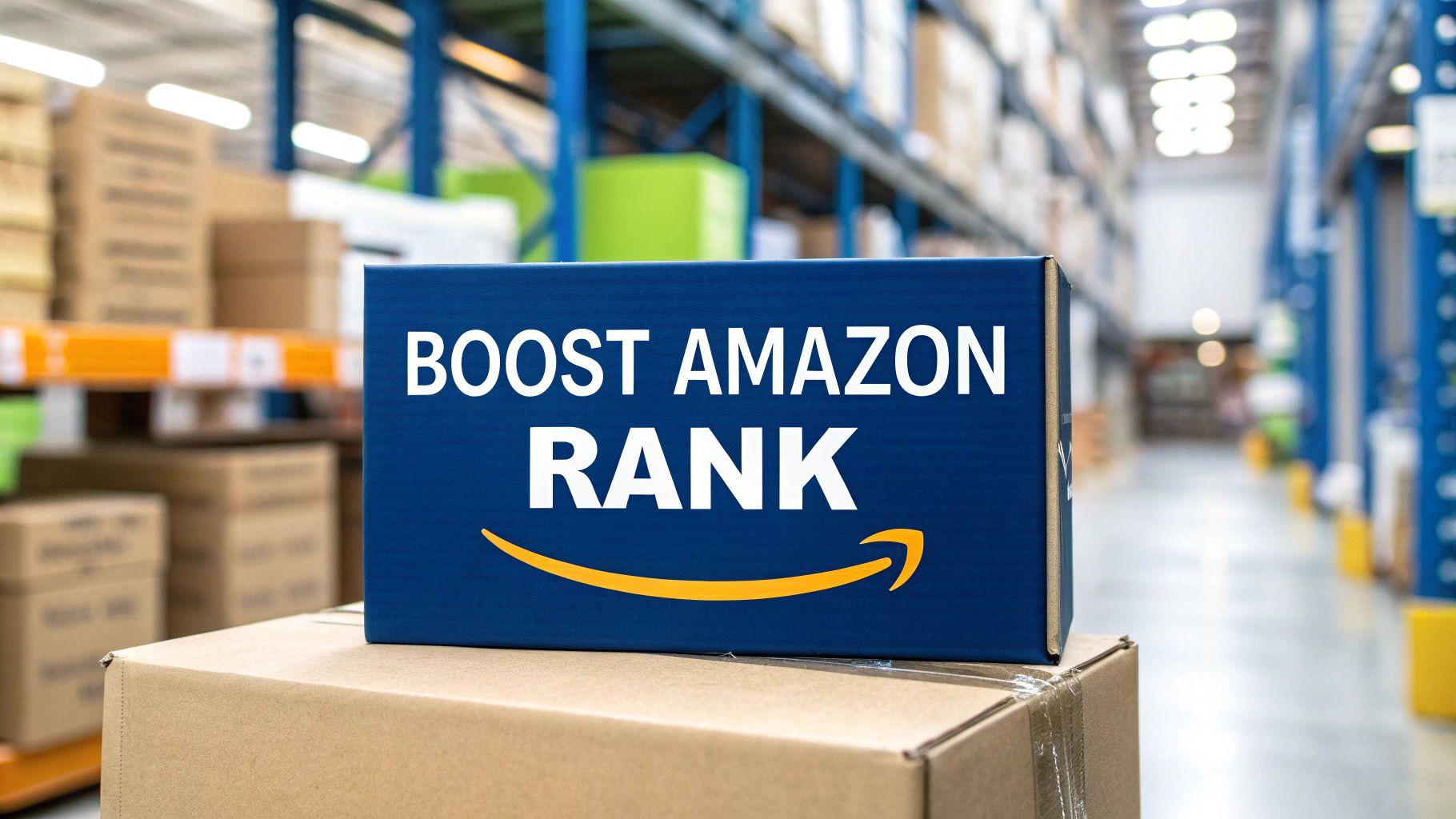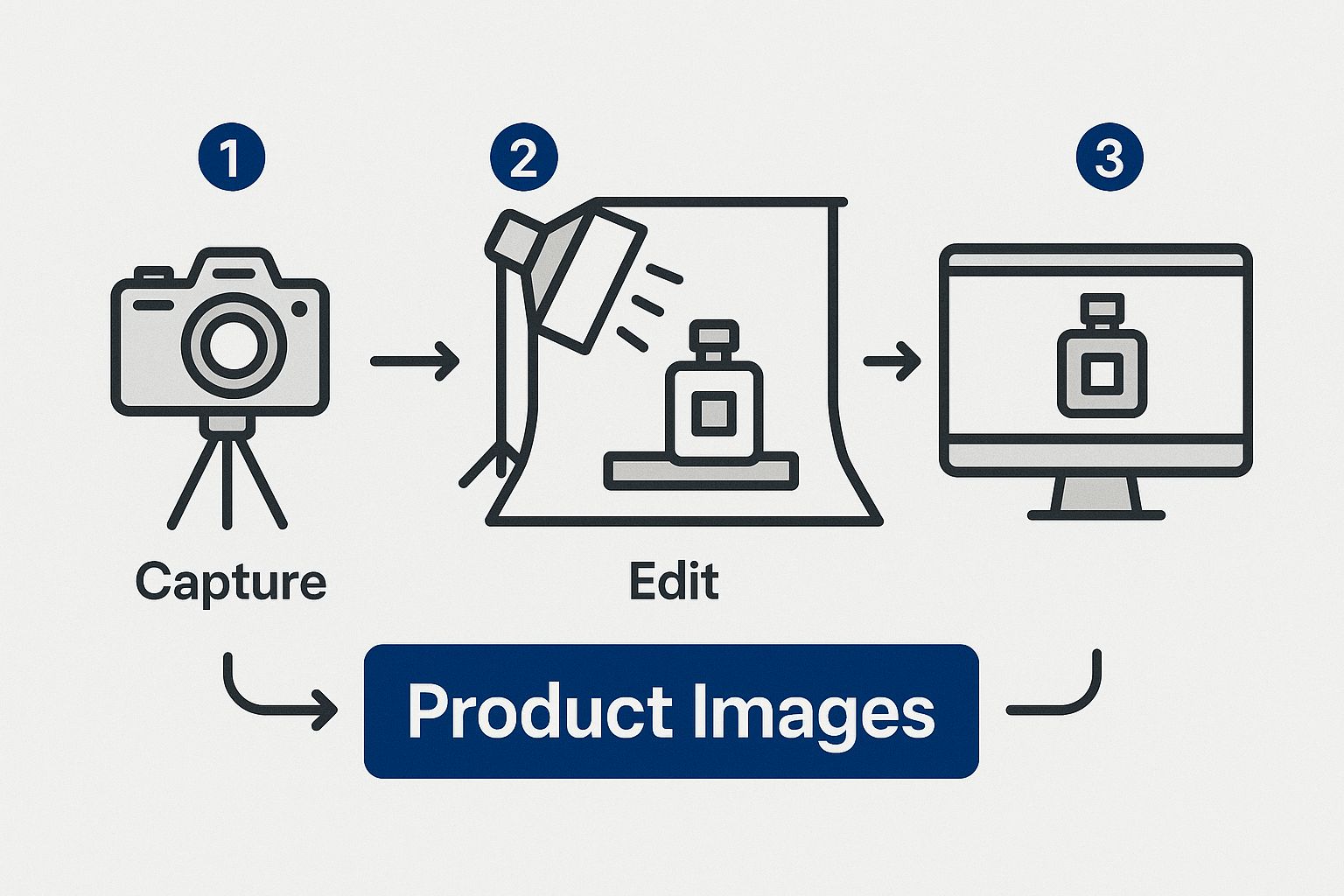How to Improve Amazon Ranking: PPC as the Lever for Organic Growth
Learn how to improve Amazon ranking with a data-driven playbook. Discover actionable strategies for SEO, PPC, and sales velocity to master the A10 algorithm.

To improve your Amazon ranking, you must "train" the A10 algorithm to see your product as the most relevant, highest-performing solution for a customer's search. This isn't about gaming the system; it's about systematically proving your product's value through sales velocity, conversion rates, and customer satisfaction—with strategic PPC as the primary lever. A paid sale and an organic sale are indistinguishable signals of performance to Amazon. This is the key to building a profitable, sustainable ranking strategy.
Your Modern Playbook for Amazon Search Dominance

Let's be blunt: the old tactics of keyword stuffing and chasing vanity metrics are obsolete. Sustainable success on Amazon requires a performance-first framework built for profitable scale. It’s time to stop guessing and start pulling the levers that directly impact revenue and market share. This playbook is for leaders focused on making smarter, data-driven decisions that leverage paid media to fuel organic growth.
The scale of Amazon is immense. The platform serves a global customer base of over 310 million people who place nearly 12 million orders daily, generating upwards of $1.3 billion in daily revenue. With over 9.7 million sellers competing for visibility, simply existing is not a strategy. You can get a clearer picture of the landscape with these Amazon statistics.
To win visibility, you must master the algorithm.
What Really Drives Amazon's A10 Algorithm?
At its core, Amazon's ranking system is a predictive engine for customer satisfaction. It prioritizes products it believes customers are most likely to purchase and be happy with. It rewards sellers who consistently send positive signals related to relevance, performance, and the customer experience.
Think of it as feeding the algorithm data points. Positive data improves rank; negative data suppresses it.
| Pillar | Primary Driver | Key Optimization Actions |
|---|---|---|
| Relevance | Keyword & Product Alignment | Title, bullet points, and backend search term optimization driven by real-world PPC conversion data. |
| Performance | Sales Velocity & Conversion Rate | Driving consistent sales through strategic PPC, targeted promotions, and external traffic. |
| Satisfaction | Customer Experience | Product reviews, seller feedback, Prime eligibility (FBA), and low return rates. |
A common, costly mistake is managing Pay-Per-Click (PPC) in a silo, viewing it only as a sales channel. This is a flawed perspective. An effective strategy uses PPC as a data-gathering tool and a velocity engine. Every paid sale validates your product's relevance for a specific keyword, signaling to the A10 algorithm that your product is a top contender. This creates a powerful PPC-to-organic flywheel.
Expert Takeaway: Your objective isn't to "beat" the algorithm but to feed it the right data. By consistently sending positive signals across relevance, performance, and satisfaction, you teach Amazon that your product is the best answer to a customer's search. An integrated approach, where strategic PPC informs and fuels organic optimization, is the foundation for sustainable scale on the platform.
Building a Product Listing That Actually Converts
Your product detail page is your most critical asset on Amazon. It's not a digital brochure; it's the foundation of your entire ranking strategy. Forget keyword stuffing. To win, every element must be engineered for two audiences: the A10 algorithm and, more importantly, the human decision-maker on the other side of the screen.
A high-converting listing sends an unambiguous signal to Amazon: this product satisfies customer intent. It's where you build a data-backed case for why your product is the superior choice.
Finding the Keywords That Matter
Effective listing optimization begins with keyword research focused on commercial intent. High-volume, single-word keywords are often a waste of ad spend and effort due to hyper-competition and low purchase intent. The strategic advantage lies in long-tail keywords—specific, multi-word phrases that reveal exactly what a customer wants to solve.
Tools like Helium 10 are invaluable for this, allowing you to analyze competitor strategies and identify search terms that are already driving revenue.
- Problem-Solving Keywords: Target phrases that describe a pain point (e.g., "durable dog chew toy for aggressive chewers").
- Use-Case Keywords: Find terms that explain how or where a product is used (e.g., "lightweight hiking backpack for day trips").
- Audience-Specific Keywords: Identify terms that speak to a niche demographic (e.g., "ergonomic keyboard for carpal tunnel").
This isn't about list-building. It's about understanding the customer's mindset to craft messaging that resonates and drives conversions.
Writing Copy That Sells, Not Just Describes
With your target keywords identified, the next step is to weave them into compelling, benefit-driven copy. Your title, bullet points, and description must work in unison to tell a persuasive story.
Your title is your most heavily weighted SEO asset. It must lead with your primary keyword phrase while being readable and compelling enough to earn the click on a crowded search results page.
Your bullet points are your sales pitch. Stop listing features. Instead, translate every feature into a tangible benefit or a solution to a problem.
Performance-Driven Example:
- Feature (Generic): "Made with 100% ripstop nylon."
- Benefit (Actionable): "Tear-Resistant Ripstop Nylon: Built to withstand rugged trails so you can explore without worrying about snags or damage."
This simple reframing transforms a dry spec into a value proposition, helping the customer visualize a better experience with your product.
The Power of Great Visuals and A+ Content
Words alone are not enough. High-quality visuals are non-negotiable. Since customers cannot physically interact with your product, your images and videos must do the work of demonstrating value, quality, and use cases. Invest in professional photography showing the product from multiple angles, in-use, and with clear scale references.
A+ Content is your opportunity to solidify brand authority. Use this space to:
- Tell your brand story visually.
- Proactively answer common customer questions.
- Use comparison charts to upsell or cross-sell related products.
- Reinforce key benefits with lifestyle imagery and compelling graphics.
A well-executed A+ Content layout can significantly increase your conversion rate—a direct, positive signal to Amazon's ranking algorithm. It's no surprise that top-tier brands lean heavily on these features, along with Fulfillment by Amazon (FBA). A staggering 82% of sellers use FBA because the Prime badge is a massive conversion driver. Among the 9.7 million sellers worldwide, those who master both their listings and their fulfillment strategy are the ones who consistently win. You can dig deeper into what sets them apart with these key seller statistics.
PPC: The Accelerator for Your Organic Rank
Viewing Pay-Per-Click (PPC) as a mere advertising expense is one of the most significant strategic errors a brand can make on Amazon. You aren't just buying clicks; you're buying data and sales velocity.
Smart brands understand that PPC is a direct investment in organic ranking. It is the most efficient and controllable method for generating the performance data required to climb the search results page (SERP) and build a defensible asset.
The A10 algorithm is driven by performance, primarily sales velocity for specific keywords. A data-driven PPC campaign is your primary tool for generating that initial velocity, proving to the algorithm that your product converts. You are actively training Amazon to favor your listing. Your product imagery is the engine of this process.

Compelling visuals drive the click-through and conversion rates in your PPC campaigns, which in turn fuels the organic ranking flywheel.
Use Sponsored Products to Validate and Dominate
For new products, Sponsored Products campaigns are your validation engine. Instead of guessing which keywords will perform, PPC provides real-world, empirical data. By running targeted campaigns, you can quickly identify which search terms drive profitable sales, not just unqualified clicks.
This process uncovers your 'hero' keywords—the high-conversion terms that signal perfect alignment with customer intent. Once identified, these proven keywords must be integrated into your product title, bullet points, and backend search terms.
This creates a powerful flywheel effect:
- Launch & Test: Target a broad but relevant keyword set with Sponsored Products.
- Analyze & Validate: Isolate the exact search terms driving sales at a profitable ACOS (Advertising Cost of Sale).
- Optimize & Integrate: Embed these proven, high-performing keywords into your product listing copy.
- Rank & Scale: As conversion rates on these terms increase, your organic rank for them will follow.
Your ad spend becomes an R&D investment that pays dividends in long-term organic dominance.
Defend Your Digital Shelf Space
For established products, the strategic focus of PPC shifts from validation to defense. Competitors are actively bidding on your branded terms and running Sponsored Display ads on your product detail pages to siphon away your customers. A defensive PPC strategy is not optional.
Expert Insight: Allowing competitors to advertise on your listings or outrank you for your own brand name isn't just a lost sale—it's an erosion of brand equity and a loss of the sales velocity that sustains your high rank.
Sponsored Brands ads secure the premium banner position at the top of the SERP, establishing your brand as the authority for your core terms and pushing competitors below the fold. It's a power move that signals category leadership to both customers and the algorithm.
The PPC-to-Organic Feedback Loop
The ultimate goal is a self-sustaining growth engine where paid advertising and organic rank are in a constant, positive feedback loop. Every dollar of strategic ad spend should contribute to your long-term organic footprint. This begins with analyzing your advertising data not just for ACOS, but for search term performance.
Your search term report is a goldmine of customer intelligence, revealing the exact language real customers use before making a purchase. For a deeper analysis of this process, our guide on Amazon PPC keyword research outlines how to convert this raw data into a tangible ranking strategy.
By continuously extracting these proven, customer-generated keywords from PPC reports and integrating them into your listing, you ensure your organic strategy is always synchronized with real-world buyer behavior. Your listing transforms from a static page into a dynamic asset that adapts to the market, solidifying its position at the top of the search results.
Driving Sales and Mastering Key Performance Metrics
A perfectly optimized listing gets you in the game, but consistent sales velocity wins the race. Amazon's algorithm rewards products that sell well and maintain high levels of customer satisfaction. To climb the rankings, you must master the performance metrics that signal a winning product.
This is about building sustainable momentum, not chasing temporary sales spikes. Every sale is a data point telling Amazon your product is a reliable choice for its customers. This creates a virtuous cycle: increased sales improve your rank, which drives more visibility, leading to more sales.
The Best Sellers Rank Isn't Just for Show
The Best Sellers Rank (BSR) is a real-time indicator of your sales momentum relative to other products in the same category, updated hourly. While the exact formula is proprietary, it's clear that recency of sales is the most heavily weighted factor.
Consistent sales result in a better (lower) BSR. This not only increases visibility within Amazon's ecosystem (e.g., on "Best Sellers" pages) but also serves as powerful social proof to shoppers. You can learn more about how BSR reflects sales trends on zikanalytics.com.
Expert Takeaway: Do not dismiss BSR as a vanity metric. It's a critical KPI for your product's health. A steady decrease in your BSR (lower is better) is a clear sign your strategy is effective. Conversely, a sudden increase is an early warning that requires immediate investigation—perhaps a new competitor has emerged or your ad performance has declined.
Proven Ways to Boost Your Sales Velocity
Sustaining sales velocity requires a multi-faceted approach beyond just PPC. Top-performing brands employ a strategic mix of tactics to keep the sales engine running.
Here are a few proven strategies:
- Strategic Promotions and Lightning Deals: These are excellent for creating urgency and driving a significant, short-term sales surge. Use them during key shopping periods or to accelerate a new product's launch. The resulting spike in sales can provide a powerful, positive jolt to your BSR and organic rank.
- Virtual Product Bundles: A smart tactic to increase Average Order Value (AOV) is to create virtual bundles that pair your primary product with a complementary item. This increases total sales volume and introduces customers to more of your catalog.
- Drive High-Intent External Traffic: Funnel engaged customers from your email lists, social media channels, or blog directly to your product listings. Better yet, leverage Amazon's Brand Referral Bonus program to receive a bonus on these attributed sales, effectively lowering your customer acquisition costs while feeding Amazon valuable sales data.
Don't Let Poor Account Health Sink You
All the sales velocity in the world is useless if your account health is poor. Amazon is relentlessly focused on the customer experience and penalizes sellers who fail to meet its performance standards. These negative signals can silently sabotage your ranking efforts.
Monitoring these metrics is non-negotiable for long-term success.
Key Performance Metrics and Their Impact on Ranking
| Metric | What It Measures | Direct Impact on Ranking |
|---|---|---|
| Order Defect Rate (ODR) | The percentage of orders with negative feedback, A-to-z claims, or credit card chargebacks. Must remain below 1%. | A high ODR is a critical red flag for Amazon that can lead to listing suppression or account suspension, effectively zeroing out your rank. |
| Seller Feedback Rating | Your overall score from customers on the purchasing experience (shipping, packaging, customer service). | While indirect, a low rating erodes buyer trust, which can depress your conversion rate and negatively impact your ranking over time. |
| Late Shipment Rate | The percentage of orders shipped after the expected date. Must remain below 4%. | Consistently late shipments signal unreliability to Amazon, damaging your standing and risking penalties that hurt visibility. |
Maintaining excellent account health is fundamental. It demonstrates to Amazon that you are a reliable partner worthy of being promoted to its customers. Wasted ad spend is another common pitfall that drags down performance. Our guide on mastering Amazon Ads negative keywords provides a framework for ensuring your budget is allocated only to traffic that converts.
Get Proactive and Build Social Proof with Reviews

Let's be direct. An optimized listing and a strong sales strategy are table stakes. The true differentiator is social proof. Authentic customer reviews are what convert a prospective buyer. Both the quantity and quality of your reviews are significant conversion factors, making them critical inputs for the A10 ranking algorithm.
A passive "wait and hope" approach to reviews is a recipe for failure, typically resulting in a slow accumulation of feedback skewed toward dissatisfied customers. You need a proactive, compliant strategy to build a review base that accelerates growth.
This creates another flywheel: more positive reviews increase your conversion rate, which drives more sales. Those sales, in turn, create more opportunities to generate reviews. This self-sustaining cycle helps lock in a high ranking over the long term.
Make Your Review Requests Systematic
Amazon provides a powerful—and fully compliant—tool within Seller Central: the ‘Request a Review’ button. Using this feature triggers a standardized email to the customer between 5 and 30 days post-delivery, soliciting both a product review and seller feedback.
While effective, manual execution is not scalable. Automation tools that trigger these requests systematically are essential for any serious seller. This ensures you capture every opportunity, creating a consistent flow of incoming reviews without violating Amazon's strict communication policies.
Expert Takeaway: Consistency is paramount. A steady stream of recent reviews is a far more powerful ranking signal than an old batch of reviews from six months ago. Automating the ‘Request a Review’ function is the most efficient and scalable method for building and maintaining this crucial momentum.
Use the Amazon Vine Program for a Head Start
Launching a product with zero reviews is an uphill battle. The Amazon Vine program provides a powerful solution. Vine invites Amazon’s most trusted reviewers ("Vine Voices") to receive your product for free in exchange for an honest, unbiased review.
This is a strategic investment. You pay enrollment fees per parent ASIN and provide the products at no cost, but the ROI can be substantial.
- Velocity: Generate up to 30 high-quality reviews quickly, establishing immediate social proof.
- Credibility: Vine reviews are marked with a special badge, signaling a higher level of trust to shoppers.
- Market Intelligence: This early, detailed feedback is invaluable for refining your listing or even improving your product before scaling ad spend.
Vine is a strategic choice, particularly for launches in competitive categories. It's one of the fastest ways to overcome the "zero review" barrier and begin generating sales velocity.
Turn Customer Feedback into Actionable Intel
Your review section is a rich source of customer intelligence. Look beyond the star rating and analyze the text of both positive and negative reviews to identify trends in sentiment and language.
Are customers consistently praising a specific feature? Highlight it in your bullet points and A+ Content. Are they confused about assembly? Add an instructional image or video. This closes the feedback loop, allowing you to use your customers' own words to strengthen your listing, preemptively answer questions, and improve your conversion rate.
This holistic view is essential for anyone serious about improving their Amazon ranking. Reviews are a critical piece, but they work in concert with a comprehensive advertising strategy. For a deeper look, our guide on comprehensive Amazon advertising optimization covers how to build a well-rounded plan.
Got Questions About Your Amazon Rank? Let's Talk.
You have the playbook, but executing within the complex Amazon ecosystem presents challenges. As you implement these strategies, questions will arise. Here are no-nonsense answers to the most common and critical questions we hear from e-commerce leaders.
"Seriously, How Long Will This Take?"
There's no single timeline; it depends on category competitiveness and the aggressiveness of your strategy.
For a new product launch with a well-funded PPC strategy and targeted promotions, you can often see positive movement in sales and BSR within 1-2 weeks. Similarly, optimizing the content on an existing listing can yield initial results in the same timeframe.
However, achieving a defensible page-one ranking is a long-term initiative. Plan for 3-6 months of consistent sales velocity, review acquisition, and meticulous PPC management to solidify a top position.
Expert Takeaway: Amazon’s algorithm rewards momentum. It favors steady, consistent performance over short, erratic bursts of activity. This is a marathon, not a sprint.
"Should I Drive Traffic from My Website to My Amazon Listing?"
Yes, but only if that traffic is high-intent and primed to convert.
Sending cold traffic from a generic social media ad directly to your product page is a surefire way to damage your conversion rate. When shoppers land on your page and bounce without purchasing, it sends a strong negative signal to the algorithm.
The smarter strategy is to warm up the audience first. Use content on your blog, email list, or targeted social campaigns to build interest before directing them to Amazon. Crucially, enroll in Amazon's Brand Referral Bonus program. This provides a bonus on sales attributed to external traffic, transforming it from a simple traffic play into a profitable, rank-boosting channel.
"Help! My Ranking Just Tanked. What Do I Check First?"
First, don't panic. A sudden rank drop requires a systematic diagnosis.
Here is our standard diagnostic checklist:
- Check for Suppressions: The first stop is Seller Central. Check for listing suppressions, policy warnings, or account health alerts. These are often the root cause.
- Analyze Key Metrics: Dive into your business reports. Has your conversion rate plummeted? Did you have a stockout? Going out of stock is the fastest way to kill your rank, as sales velocity drops to zero.
- Conduct Competitive Analysis: Investigate your direct competitors. Did a new seller launch with a significantly lower price or a massive advertising budget? Your rank drop may be a reaction to a competitor's aggressive move.
- Read Recent Reviews: Scrutinize your latest customer feedback. A string of new one- or two-star reviews can dramatically impact your conversion rate and, consequently, your rank.
"What Matters More for Ranking: PPC Sales or Organic Sales?"
To the algorithm, a sale is a sale. Amazon’s primary concern is total sales velocity and the conversion rate for a given keyword. It does not differentiate between a sale that originated from a paid click versus an organic one.
However, this is where many sellers miss the strategic connection. The two are inextricably linked. PPC is the catalyst for organic rank. It is the tool you use to generate the initial sales velocity and prove to Amazon that your product is a relevant, high-converting option for your most important keywords. This initiates the flywheel.
Think of it this way: PPC is the spark that ignites the engine of organic ranking. Effective ad campaigns drive sales, which improves your organic rank, which in turn leads to more organic sales at a lower total cost.
At Headline Marketing Agency, we transform these complex ranking factors into a clear, profitable growth strategy. We don't just manage ads; we build integrated systems that leverage PPC data to achieve organic dominance, ensuring every dollar invested contributes to a valuable, long-term asset on Amazon.
Ready to move from theory to profitable execution? Schedule a consultation with our Amazon experts today.
Ready to Transform Your Amazon PPC Performance?
Get a comprehensive audit of your Amazon PPC campaigns and discover untapped growth opportunities.